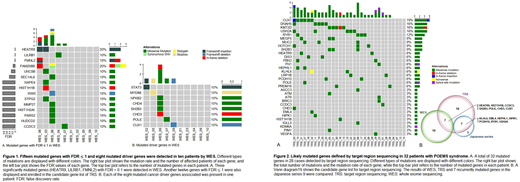Background: POEMS syndrome is a rare plasma cell dyscrasia. Despite the presence of monoclonal protein, POEMS syndrome patients commonly have less than 5% monoclonal plasma cells in the bone marrow. Only one study has reported the genetic and transcriptional features of bone marrow plasma cells, and the underlying role of aberrant plasma cells is not well understood. Herein, in the current study, we aimed to characterize the genetic profile of bone marrow CD138-positive cells from Chinese patients with newly diagnosed POEMS syndrome.
Methods: Forty-two patients with newly diagnosed POEMS syndrome based on the International Myeloma Working Group criteria at our institute were included in our study. Twenty milliliters of bone marrow aspirates was obtained and sorted by magnetic microbeads conjugated to monoclonal human anti-CD138 antibodies. The mutational features of these bone marrow plasma cells were analyzed using a two-step strategy. DNA of the bone marrow plasma cells from ten patients was first sequenced by whole exome sequencing to find significantly mutated genes and mutated driver genes, with paired peripheral blood mononuclear cells as a control. Bone marrow plasma cells of an additional thirty-two patients were then analyzed by target region sequencing to validate the mutations.
Results: Whole exome sequencing of 10 newly diagnosed patients showed a total of 170 somatic mutations in exonic regions and splicing sites. Three significantly mutated genes-LILRB1 (10%), HEATR9 (20%), and FMNL2 (10%)-and eight mutated known driver genes (MYD88, NFKB2, CHD4, SH2B3, POLE, STAT3, CHD3, CUX1) were identified in five patients. The mutation spectrum of WES revealed C > T/G > A as the most common mutation type, while the mutation signature was not the same as known signatures reported in various cancer types. For significant pathway and gene ontology analysis, 69 genes with possibly pathogenic nonsynonymous mutations were selected. Mutated genes were enriched in pathways including "chromatin organization", "chromatin modifying enzymes", and "apoptosis", and terms such as "cellular anatomical entity", "regulatory region nucleic acid binding" and "centrosome" that are used to describe cellular structure construction. To evaluate the mutation prevalence of genes identified in WES, we performed target region sequencing of 77 candidate genes in 32 other patients. The candidate gene list consisted of significantly mutated genes and known driver genes identified in WES, recurrently mutated genes previously detected in POEMS syndrome, the VEGF gene, and genes of light-chain amyloidosis, multiple myeloma, hematopoietic disease or lymphoid neoplasm in the public databases. As a result, a total of 32 mutated genes were identified in 28 of 32 patients. Genes recurrently mutated in more than three patients included CUX1 (19%), DNAH5 (16%), USH2A (16%), KMT2D (16%), and RYR1 (12%). Driver genes of multiple myeloma (BIRC3, LRP1B, KDM6A, ATM) and eleven genes reported in light-chain amyloidosis were also identified in target region sequencing. Notably, VEGFA mutations were detected in one patient.
Conclusions: Heterogeneous genomic profiles of bone marrow plasma cells in POEMS syndrome were revealed in our study. The mutational landscape of POEMS syndrome might share some similarity to that of other plasma cell diseases.
No relevant conflicts of interest to declare.
Author notes
Asterisk with author names denotes non-ASH members.


